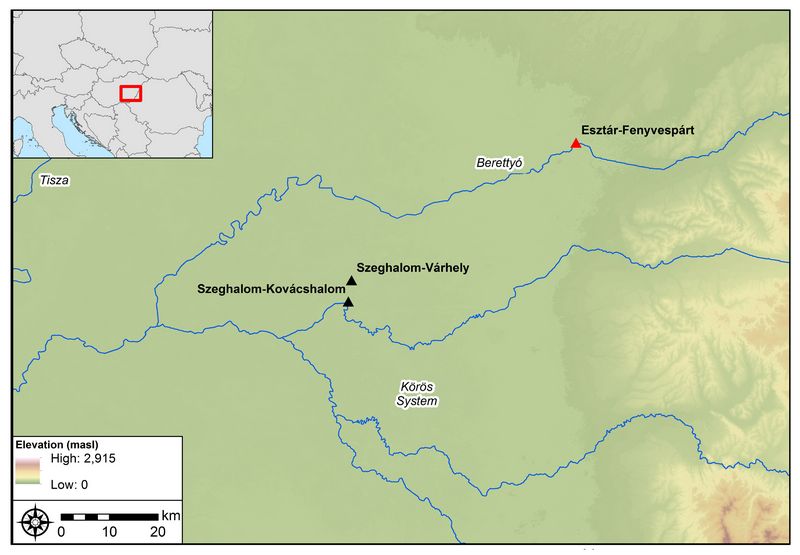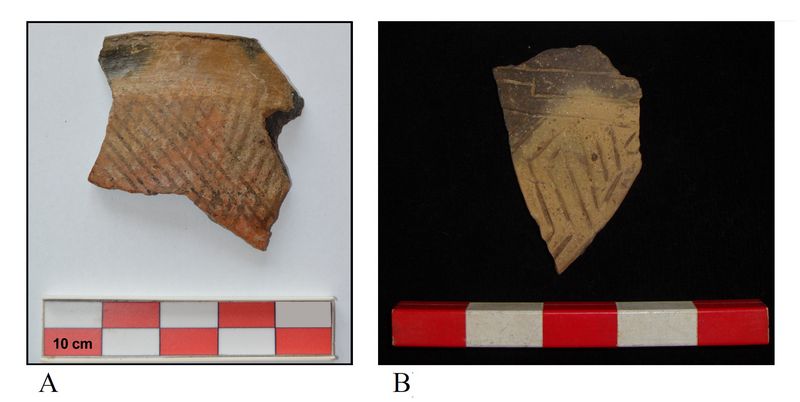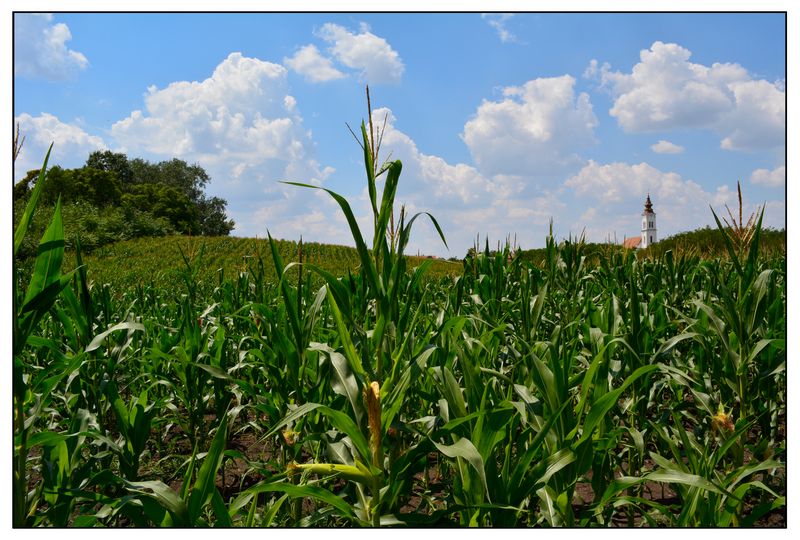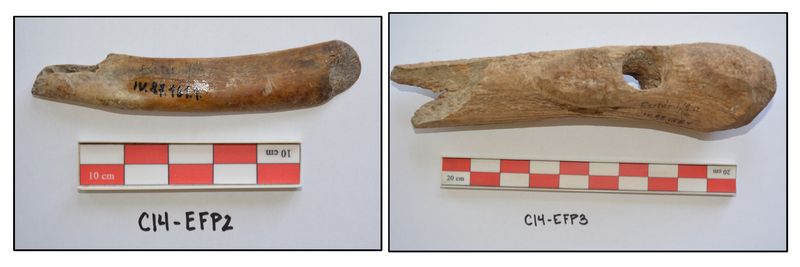Rust Family Foundation: Archaeology Grants Program
Interaction and Socio-Cultural Boundaries during the Late Neolithic
on the Great Hungarian Plain
Principal Investigator: Dr. Danielle J. Riebe
Integrative Research Center, The Field Museum of Natural History
.
Over the past six years, the Prehistoric Interactions on the Plain Project (PIPP) has investigated the extent to which interactions in the past impacted the evolution of socio-cultural boundaries. More specifically, research has focused on identifying the formation and alteration of sociocultural boundaries between Late Neolithic (5,000 – 4,600 BCE) archaeological cultural units on the Great Hungarian Plain.
Previous phases of the PIPP have demonstrated that through compositional and stylistic analyses of ceramics, as well as technological and typological analyses of lithics, it is possible to reconstruct interactions at multiple scales (including both long-distance and short-distance interactions) and to model socio-cultural boundaries between the two major Late Neolithic cultural units (i.e., the Tisza and the Herpály) in the region. While a majority of previous work has focused on reconstructing interactions between Late Neolithic communities, these interactive networks are based on the assumption that sites were contemporaneously occupied. In order to advance our understanding of the chronological nature of cultural developments during the Late Neolithic, the current (2018) project represents the initial round of radiocarbon analysis of materials from three selected Tisza and Herpály sites located along the Berettyo and Koros Rivers (fig.1).

Fig.1: Map of three sites in the Great Hungarian Plain with archaeological samples selected for 14C dating.
Project Significance and Previous Research:
Collaborative regional archaeological research conducted in Eastern Hungary over the past twenty years has resulted in a better understanding of the dynamic processes that led to regional socio-cultural developments in the prehistoric past (see Duffy 2014; Duffy et al. 2013; Gyucha 2015; Gyucha et al. 2015; Parkinson 2006; Parkinson et al. 2017; Riebe 2016; Riebe and Niziolek 2015; Salisbury 2016; Salisbury and Bácsmegi 2012). However, where research has lagged is in refining the regional chronological sequence for the Neolithic. Few studies have addressed the issue with chronology (for Late Neolithic/Early Copper Age see Neumann et al. 2014; Raczky et al. 2014; Yerkes et al. 2009) and because of this, the Neolithic subdivisions and the radiocarbon dates first established in the 1980’s (see Tálas and Raczky 1987) continue to be reified in the current literature.
Limited radiocarbon dating throughout Eastern Europe has resulted in the contemporaneity of sites in the region being determined primarily on ceramic style (fig.2). In the current, 2018 project, we began dating faunal and charcoal samples from three Late Neolithic Tisza and Herpály sites in Eastern Hungary. In doing so, it is possible to determine that the interactions and the socio-cultural boundaries reconstructed for the Late Neolithic are based on contemporaneously occupied sites.

Fig.2: Ceramics with characteristic decorations used for traditionally determining archaeological cultural units. A) Ceramic from Herpály site, Esztár-Fenyvespart, with painted geometric design in black and white. B) Ceramic from Tisza site, Szeghalom-Kovácshalom, with incised geometric design.
In regards to the previously reconstructed socio-cultural boundaries during the Late Neolithic, anthropological archaeologists have traditionally understood the emergence, growth, and spread of prehistoric peoples by delineating cultural boundaries based on the geographic distribution of similar or dissimilar cultural materials. However, as renowned anthropologist Fredrik Barth has noted, “boundaries persist despite a flow of personnel across them” (1969:9), thereby suggesting that attention should be given to the interactions between peoples. This challenges the overall concept of culture and instead of group affiliation being defined by manufactured materials the focus switches to how materials are reflective of actions, more specifically interactions, between peoples. The degree of interaction or the degree of connectivity between peoples can then be used to infer peoples’ social identity and cultural affiliation.
In order to reconstruct prehistoric interactions, it is necessary to assess multiple types of materials -such as ceramics and stone tools -and to conduct multiple types of analyses – including compositional, stylistic, and typological – at various geographical scales. Since material culture is the product of humans, materials inherently become imbued with evidence of human behavior and ideology (Plog 1995; Sackett 1990; Wiessner 1990). The technologies and processes involved in the creation, distribution, and disposal of these materials help to reinforce certain social boundaries at work within and between cultural units (Hegmon 1998). Therefore, by analyzing how objects were created, where they were constructed, and how they were circulated after production, it is possible to reconstruct socio-cultural boundaries.
The incorporation of graph theory – or more specifically, social network analysis (SNA) – has made it possible to start investigating community connectedness from a sociological perspective where behaviors and the repetition or replication of behaviors becomes the focus of the research, rather than the cultural materials themselves. In turn, this changes the definition of culture from one based solely on materials that represent bounded entities to one based on behaviors and interactions between peoples, thus resulting in people having an active role in the formation of their own identities and their own socio-cultural boundaries.
While this multi-scalar and multi-methodological approach has produced results that have been used to reconstruct interactions between sites and to model regional socio-cultural boundaries during the Late Neolithic, as noted before, without radiocarbon
 dates, it remains unclear whether these
sites engaged in interactions at the same time. By obtaining
radiocarbon dates, we have been able to firmly establish chronological
connections between sites and definitively argue for the strictly
enforced, yet permeable, Late Neolithic regional boundaries.
dates, it remains unclear whether these
sites engaged in interactions at the same time. By obtaining
radiocarbon dates, we have been able to firmly establish chronological
connections between sites and definitively argue for the strictly
enforced, yet permeable, Late Neolithic regional boundaries.Fig.3: Herpály tell site, Esztár-Fenyvespart, located in eastern Hungary
.
.
Current Funded Project (RFF-2018-75):
Goals:
With regard to the current project, the PIPP 2018 summer season had two major
goals: 1) expand the regional project to inventory ceramic, lithic, and faunal materials from a previously unstudied Herpály site, Esztár-Fenyvespart and 2) refine the chronological sequence for the Late Neolithic in Eastern Hungary by radiocarbon dating faunal and charcoal samples from two Herpály sites, Esztár-Fenyvespart and Szeghalom-Várhely, and one Tisza site, Szeghalom-Kovácshalom (figs.1 and 3).
Methodologies and Findings:
Goal 1: Research at Esztár-Fenyvespart (June 2018).
In order to accomplish the proposed goals for this season of PIPP, in June 2018 Dr. János Dani (Director of Archaeological Department at the Déri Museum) and I went through the Esztár-Fenyvespart assemblage (fig.3). This site, located on the northern edge of the Herpály territory, was excavated in the 1970’s and the archaeological assemblage remained unstudied ever since. Therefore, all materials (including ceramics, lithics, and animal bones) were inventoried, entered into a FileMaker Pro database, and then 50 ceramics were selected for compositional analysis with a new device, a portable laser ablation device at the Field Museum. (The Archaeological Institute of America’s Ellen and Charles Steinmetz Endowment for Archaeology supported this part of the research.) Results from this part of the project are still pending.
Goal 2: Refinement of Late Neolithic Chronology (June-July 2018).
In order to begin refining the Late Neolithic chronology for Eastern Hungary, samples from two Herpály sites (Esztár-Fenyvespart and Szeghalom-Várhely) and one Tisza site (SzeghalomKovácshalom) were selected from secure contexts for radiocarbon dating (contexts include burials, houses, cultural levels, and pits). All samples were sent to the University of Georgia’s Center for Applied Isotope Studies for radiocarbon analysis (see Table I).

Fig.4: Two bone tools selected for 14C analysis from Esztár-Fenyvespart.
For the site of Esztár-Fenyvespart, Drs. Dani and Riebe went through the excavation notes and discovered that the faunal assemblage from the site was destroyed in the 1980’s. However, the bone tools were preserved in the collection and three samples were selected for radiocarbon analysis (fig.4). Based on the inventory notes, the selected samples were associated with different cultural levels from a partially excavated house. Of the samples analyzed however, only two resulted in 14C dates (EFP2 and EFP3; see Table I).
A second and critical site that was included in this phase of the chronological refinement was the Herpály site of Szeghalom-Várhely. Gy. Goldman and J. Szénászky excavated the site in the 1980’s, but have only produced one minor publication about their results (Goldman and Szénászky 1998). Riebe inventoried and analyzed the ceramic and lithic assemblages from this site and included the results in her dissertation (Riebe 2016). The Herpály site of Szeghalom-Várhely is located less than 3 kilometers from the Tisza site of Szeghalom-Kovácshalom, but their ceramic and lithic assemblages are strikingly different (see Riebe 2016).
What remained to be determined was if these sites were contemporaneous with one another. To resolve this issue, in July 2018 Riebe went through the faunal and human osteological assemblages and selected six samples for 14C analysis. The selected samples were from a variety of secure Late Neolithic contexts including burials, cultural levels, and pits (SzV1-6; see Table I).
The PIPP research is closely connected with other regional projects in Eastern Hungary and as such the radiocarbon aspect of this research took on a collaborative scope. Riebe worked closely with the directors of the Körös Regional Archaeological Project (KRAP), Drs. William Parkinson and Attila Gyucha, to work on refining the Late Neolithic chronological sequence. For the past 9 years, KRAP has conducted intensive archaeological investigations at the Late Neolithic Tisza site of Szeghalom-Kovácshalom. Their research has focused on the environmental and socio-economic processes that resulted in the aggregation of people at tell sites in the Körös region during the Late Neolithic (see Gyucha et al. 2015). As part of Riebe’s dissertation, she compositionally analyzed the ceramic and lithic assemblages from the KRAP excavations at Szeghalom-Kovácshalom (see Riebe 2016).
In July 2018, Parkinson and Gyucha revisited the site and opened targeted 1x1 meter and 1x2 meter exploratory units over geophysical anomalies that were identified as houses to obtain 14C samples from various sections of the site. Since the site is already a part of Riebe’s dissertation and part of the first phase of PIPP, a total of 16 faunal, human osteological, and charcoal samples from different houses and burials at the site were selected for 14C analysis of which, the RFF funded the analysis of five samples (Szk1-15 and SzK50_1969; see Table I. Parkinson and Gyucha used internal Field Museum research funds to pay for the other 11 samples analyzed).
Results and Conclusions:
With funding from the Rust Family Foundation a total of 13 radiocarbon samples from the three sites, Szeghalom-Kovácshalom (n=5), Szeghalom-Várhely (n=6), and Esztár-Fenyvespart (n=2), were analyzed. An additional 11 charcoal, faunal, and human osteological samples from Szeghalom-Kovácshalom were sent in for radiocarbon analysis at the same time (see footnote two).
The 14C results illustrate contemporaneous developments across from the Great Hungarian Plain from the Middle Neolithic to the Late Neolithic. Earliest dates from the Tisza site of Szeghalom-Kovácshalom and the Herpály site of Szeghalom-Várhely (SzK11 and SzV6) show contemporaneous tell formation at both sites in the Middle Neolithic with continued habitation occurring till the end of the Neolithic around 4,600 BCE (see table 1).

Table 1: Samples sent to the Center for Applied Isotope Studies, University of Georgia and sample context.
At the Herpály tell of Esztár-Fenyvespart, radiocarbon dates illustrate that the site also was occupied during the Late Neolithic and then reoccupied during the Bronze Age. This pattern of tell usage and abandonment at the end of the Neolithic with reoccupation occurring during later periods including the Copper Age (SzK3, 4, 12, and 13; see Gyucha et al. 2009; Hegedus and Makkay 1987) and the Bronze Age (SzK1 and EFP2; see Kalicz and Raczky 1984; Neumann et al. 2014) is well documented for this region and the dates obtained as part of this project reaffirm this regional phenomena (see fig.5 for all dates displayed together).

Fig.5: All 14C dates analyzed in 2018 from the sites of Szeghalom-Kovácshalom (SzK), Szeghalom-Várhely (SzV), and Esztár-Fenyvespart (EFP).
Ongoing Plans and Final Publication:
The results generated from the current project have been disseminated at the annual meeting for the Society for American Archaeology in Albuquerque, New Mexico in April 2019. Following that conference, an article will be drafted that discusses the timing of tell developments in relation to regional socio-cultural diversification in eastern Hungary during the Neolithic. In summer 2019, PIPP will begin its first season of a multi-year project with funding from a NSF senior grant in archaeology. Additional 14C dates from another Herpály site, Csökmo-Káposztás Domb, will be obtained and added to these recent dates secured in the 2018 project.
References:
Barth, F. 1969. Ethnic Groups and Boundaries: The Social Organization of Cultural Difference. Little Brown and Co., Boston.
Duffy, P. R. 2014. Complexity and Autonomy in Bronze Age Europe: Assessing Cultural Developments in Eastern Hungary. Prehistoric Research in the Körös Region 1. Archaeolingua, Budapest.
Duffy, P. R., W. A. Parkinson, A. Gyucha, R. W. Yerkes. 2013. Coming Together, Falling Apart: A Multiscalar Approach to Prehistoric Aggregation and Interaction on the Great Hungarian Plain. In From Prehistoric Villages to Cities: Settlement Aggregation and Community Transformation, edited by J. Birch, pp. 44-62. Routledge, New York.
Goldman, Gy. and J. Szénászky. 1998. Topographic Research on the Neolithic Settlements in Békés Sárrét. In Archaeometrical Research in Hungary II, edited by L. Költo and L. Bartosiewicz, pp. 13-19. Hungarian National Museum and Directorate of Somogy Museum, Budapest.
Gyucha, A. 2015. Prehistoric Village Social Dynamics: The Early Copper Age in the Körös Region. Prehistoric Research in the Körös Region 2. Archaeolingua, Budapest.
Gyucha, A., W. A. Parkinson, R. W. Yerkes. 2009. A Multi-Scalar Approach to Settlement Pattern Analysis: The Transition from the Late Neolithic to the Early Copper Age on the Great Hungarian Plain. In Reimagining Regional Analyses, edited by T. Thurston and R. Salisbury, pp. 100-129. Cambridge University Press, Cambridge.
Gyucha, A., R. W., Yerkes, W. A. Parkinson, N. Papadopoulos, A. Sarris, P. R. Duffy, and R. B. Salisbury. 2015. Settlement Nucleation in the Neolithic: A Preliminary Report of the Körös Regional Archaeological Project’s Investigations at Szeghalom-Kovácshalom and Vészto-Mágor. In Neolithic and Copper Age between the Carpathians and the Aegean Sea. Chronologies and Technologies from the 6th to the 4th Millennium BCE (Archäologie in Eurasien 31), edited by S. Hansen, P. Raczky, A. Anders and A. Reingruber, pp. 129-142. Dr. Rudolf Habelt, Bonn.
Hegedus, K. and J. Makkay. 1987. Vészto-Mágor. A settlement of the Tisza culture. In The Late Neolithic in the Tisza region, edited by L. Tálas and P. Raczky, pp. 85–103. Directorate of the Szolnok County Museums, Budapest–Szolnok.
Hegmon, M. 1998. Technology, Style, and Social Practices: Archaeological Approaches. In The Archaeology of Social Boundaries, edited by M. T. Stark, pp. 264-279. Smithsonian Press, Washington D.C.
Kalicz, N. and P. Raczky. 1984. Preliminary Report on the 1977-1982 Excavations at the Neolithic and Bronze Age Tell Settlement of Berettyóújfalu-Herpaly. Acta Archaeologica Academiae 38:85-136.
Neumann, D., Zs. Siklósi, R. Scholz, M. Szilágyi. 2014. Preliminary Report on the first season of fieldwork in Berettyóújfalu-Szilhalom. Dissertationes Archaeologicae ex Instituto Archaeologico Universitatis de Rolando Eötvös Nominatae Ser. 3. No. 2:377–404.
Parkinson, W. A. 2006. The Social Organization of Early Copper Age Tribes on the Great Hungarian Plain. BAR International Series 1573. Archaeopress, Oxford.
Parkinson, W. A., A. Gyucha, P. Karkanas, N. Papadopoulos, G. Tsartsidou, A. Sarris, R. W. Yerkes. 2017. A Landscape of Tells: Geophysics and Microstratigraphy at Two Neolithic Tell Sites on the Great Hungarian Plain. Journal of Archaeological Science https://doi.org/10.1016/j.jasrep.2017.07.002.
Plog, S. 1995. Approaches to Style: Complements and Contrasts. In Style, Society, and Person: Archaeological and Ethnological Perspectives, edited by C. Carr and J. E. Neitzel, pp. 369-392. Plenum Press, New York.
Raczky, P. A. Anders, Zs. Siklósi. 2014. Trajectories of Continuity and Change between the Late Neolithic and the Copper Age in Eastern Europe. In The Neolithic and the Eneolithic in Southeast Europe New Approaches to Dating and Cultural Dynamics in the 6th to 4th Millennium BC, edited by W. Schier and F. Drasovean, pp. 319-346. Verlag Marie Leidorf GmbH, Rahden/Westf.
Riebe, D. J. 2016. Interaction and Socio-Cultural Boundaries During the Late Neolithic on the Great Hungarian Plain. Ph.D. Dissertation. Department of Anthropology, University of Illinois at Chicago, Chicago.
Riebe, D. J. and L. C. Niziolek. 2015. Investigating Compositional Variation of Ceramic Materials during the Late Neolithic on the Great Hungarian Plain – Preliminary LA-ICPMS Results. Open Geosciences 7(1): 423-445.
Sackett, J. R. 1990. Style and Ethnicity in Archaeology: The Case for Isochrestism. In The Uses of Style in Archaeology, edited by M. W. Conkey and C. A. Hastorf, pp. 32–43. Cambridge University Press, Cambridge.
Salisbury, R. B. 2016. Soilscapes in Archaeology: Settlement and Social Organization in the Neolithic of the Great Hungarian Plain. Prehistoric Research in the Körös Region 3. Archaeolingua, Budapest.
Salisbury, R. B. and G. Bácsmegi. 2012. Neolithic Archaeology and Soilscapes Körös Area: 2011 – Survey Year. Newsletter of the Archaeological Geology Division of the
Geological Society of America, April 2012, 6-7.
Tálas, L. and P. Raczky. 1987. The Late Neolithic in the Tisza region. Directorate of the Szolnok County Museums, Budapest–Szolnok.
Wiessner, P. 1990. Is there a Unity to Style? In The Uses of Style in Archaeology, edited by M. W. Conkey and C. A. Hastorf, pp. 105-112. Cambridge University Press, Cambridge.
Yerkes, R. W., A. Gyucha, W. A. Parkinson. 2009. A Multi-Scalar Approach to Modeling the End of the Neolithic on the Great Hungarian Plain using Calibrated Radiocarbon Dates. Radiocarbon 51(3): 1071-1109.
|
|
Recent Foundation grants: general Archaeology Grants Program w/map
Copyright © 2019 Rust Family Foundation